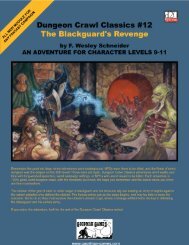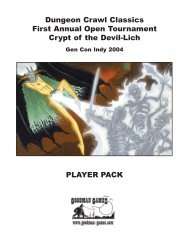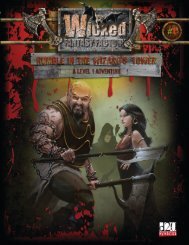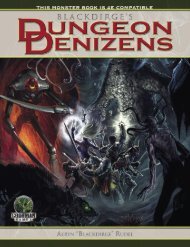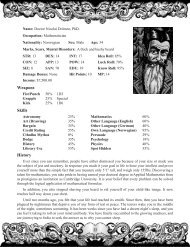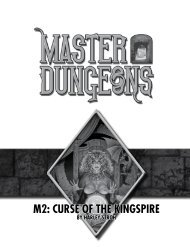Dungeon Crawl Classics #35 Preview #2 - Goodman Games
Dungeon Crawl Classics #35 Preview #2 - Goodman Games
Dungeon Crawl Classics #35 Preview #2 - Goodman Games
Create successful ePaper yourself
Turn your PDF publications into a flip-book with our unique Google optimized e-Paper software.
<strong>Dungeon</strong> <strong>Crawl</strong> <strong>Classics</strong> <strong>#35</strong><br />
Gazetteer of the Known Realms<br />
Contents<br />
Introduction . . . . . . . . . . . . . . . . . . . . . . . . . . . . . . . . . . . . . . . . . . . . . . . . . . . . . . . . . . . .2<br />
Chapter 1: The Northlands . . . . . . . . . . . . . . . . . . . . . . . . . . . . . . . . . . . . . . . . . . . . . .3<br />
Chapter 2: The Southlands . . . . . . . . . . . . . . . . . . . . . . . . . . . . . . . . . . . . . . . . . . . . . .43<br />
Chapter 3: The Lostlands . . . . . . . . . . . . . . . . . . . . . . . . . . . . . . . . . . . . . . . . . . . . . . .64<br />
Chapter 4: Geographic Features . . . . . . . . . . . . . . . . . . . . . . . . . . . . . . . . . . . . . . . . .81<br />
Chapter 5: Organizations . . . . . . . . . . . . . . . . . . . . . . . . . . . . . . . . . . . . . . . . . . . . . .100<br />
Chapter 6: Beyond the Known Realms . . . . . . . . . . . . . . . . . . . . . . . . . . . . . . . . . . .111<br />
Chapter 7: History of the Northlands . . . . . . . . . . . . . . . . . . . . . . . . . . . . . . . . . .113<br />
www.goodmangames.com<br />
1
2<br />
The grimoire you hold in your hands first surfaced<br />
in America more than one hundred years ago.<br />
Discovered in the ruins of the Great Chicago Fire<br />
of 1871, the tome made its way from collector to collector<br />
and finally to the good Doctor S_________ W____,<br />
who—knowing my interest in bibliotic obscurities—<br />
entrusted the tome to me for translation.<br />
Upon inspection, the first thing one notices about the<br />
tome is its smell: musty incense, wood smoke, and oiled<br />
steel. Bound in splitting leather and scarred with runes,<br />
the cover conjures visions of the ceaseless march of the<br />
ages.<br />
Between those thick covers are several hundred handwritten<br />
pages, each inked and illuminated in dyes and<br />
pigments that bear little resemblance to any known by<br />
modern bibliophiles. Sadly, the bulk of the tome has been<br />
damaged beyond recognition or is simply untranslatable.<br />
But from the scattered passages, a determined researcher<br />
may infer this much:<br />
The codex is the work of a handful of unidentified<br />
scriveners or monks, living during what might be termed<br />
a Dark Age—a time of marauding savages, unknown<br />
powers, and desperate heroes. By collecting the sum of<br />
their knowledge into a single work, the<br />
tome, these scribes hoped to stave<br />
off the press of darkness and<br />
barbarism.<br />
Whether or not their<br />
gambit was successful,<br />
and if they<br />
accomplished<br />
with pen and ink<br />
what sword and<br />
spear could not,<br />
will likely never<br />
be known.<br />
The codex is seventh<br />
in a work of<br />
twenty-one volumes,<br />
Introduction<br />
and serves as catalog for the later volumes and a brief<br />
gazetteer of what the scribes refers to as the Umbris<br />
Mundus. The first term, “shadow,” certainly refers to the<br />
threats that plagued their civilization. The second translates<br />
to “world,” but whether the scribes intended<br />
“world” as we understand it, or “continent,” or simply<br />
“the lands of our lord-liege,” remains unclear.<br />
Similarly, a thousand other priceless historical details,<br />
deemed too trivial or universally understood to record,<br />
remain lost, waiting for future scholars to coax them<br />
from the mists of antiquity. Given the absence of accurate<br />
maps, it remains for the reader to decide if the codex is a<br />
pre-history of our world, or an inexplicable shadow-echo<br />
of another, unnamed realm.<br />
We have done our best to present this translation of the<br />
tome in its original context, without attempting to conceal<br />
its flaws. I encourage the good readers to fill in the<br />
gaps with their own reasoning and logic, so that the<br />
world of the scribes might live on in their imaginations—<br />
and perhaps stave off the darkness a bit longer.<br />
Harley Stroh<br />
Curator of Esoteric Collections<br />
Chicago, 2006
The nations of the Northlands are steeped in<br />
eldritch history, and are often—quite literally—<br />
built upon the ruins of those that came before<br />
them. The mightiest citadels stand on the ruins of<br />
dwarfholds, holy sanctums are built atop fallen rings of<br />
druidic stones, and loggers harvest timber from faehaunted<br />
glades. Every spring a farmer uncovers new<br />
ruins beneath his fields, often warded in dead languages<br />
unknown to modern sages. The past is the North’s constant<br />
companion, dark-cowled and mysterious, revealing<br />
tales of high sorcery, heroism, and slumbering horrors at<br />
her leisure.<br />
A careful study of these ruins, and of the scrolls and<br />
tomes brought back by explorers, reveals that the kings<br />
of men are not the first to rule the Northlands. Some legends<br />
speak of ancient races and gods familiar to scholars,<br />
while others whisper of foul cults and forbidden powers.<br />
Sages debate these epochs endlessly, but all can agree<br />
that the current age is rightly called the Reign of Man.<br />
Whether by mortal ambition or some mystic turning of<br />
the cosmos, the power of the Gods has waned, permitting<br />
the rise of heroes, and granting men, elves, dwarves, and<br />
the wee-folk the freedom to fashion their own destinies.<br />
This waning has also ushered in a new host of threats and<br />
dangers. The marauding armies of the Scourgelands<br />
threaten the heart of the civilized world, barbarians raid<br />
with greater frequency each spring thaw, and shrieking<br />
comets tumble from the night sky; witches, seers, and<br />
astrologers alike presage a time of coming darkness.<br />
It remains to be seen whether this is a prelude to an age<br />
of prosperity and peace, or an end to humanity’s reign.<br />
Climate and Seasons<br />
The Northlands encompass ecologies ranging from the<br />
temperate grasslands and vales of Crieste to the inhospitable<br />
wastes of the north. Climates and seasons are<br />
dependent largely on latitude and precipitation, with certain<br />
marked exceptions due to geographic and magical<br />
anomalies.<br />
Chapter 1<br />
The Northlands<br />
The Criestine Empire and the other nations adjacent to<br />
the Lirean Sea enjoy mild summers, brief winters, and<br />
long springs and autumns. Dense stands of deciduous<br />
hardwoods offer sturdy beams for shipbuilding, while<br />
fertile soils provide abundant crops and grasslands for<br />
cattle and sheep.<br />
Moving north, the climate grows steadily cooler, reflected<br />
by a marked hardiness in the people and beasts. The<br />
Warlands, renowned for their wealth of natural resources,<br />
expect deep winters with heavy snowfall and months of<br />
isolation. The summers, unmitigated by the cooling<br />
Lirean Sea, can be equally severe, and times of hardship<br />
force farmers to augment their crops and herds with wild<br />
game. The deciduous forests slowly give way to primeval<br />
coniferous stands and the mighty Ashwood groves.<br />
East, across the vast ranges of the Ul Dominor<br />
Mountains, are the Mirdar-Luminar Steppes. The little<br />
moisture that reaches the steppes is brought by raging<br />
storms that sweep down from Hoarfrost Bay. In years of<br />
drought, the steppes become a vast tinderbox, and wildfires<br />
rage up and down the high prairie, tainting the air<br />
for hundreds of leagues in every direction and shading<br />
the sunsets the color of spilled blood.<br />
North of both the Mirdar-Luminar Steppes and the<br />
Warlands are endless swaths of high tundra, gnarled oak,<br />
and icy wastes. Here the temperature retreats below<br />
freezing every night of the year, and savage beasts swarm<br />
the land. While hunters, outlaws, and hermits choose to<br />
make their home in the forbidding wastes, they are the<br />
exception, not the rule.<br />
Timekeeping and<br />
Celestial Bodies<br />
The Emperor of Crieste, in his divine wisdom, determines<br />
all units of measurement, including the span of the<br />
days, months, and years. Following the end of the<br />
Interregnum, the empire adopted a sidereal calendar of<br />
365 days, but many of the smaller nations hold to the<br />
older lunar calendar.<br />
3
4<br />
Every nation and religion celebrates a host of holy days<br />
throughout the year, and travelers can expect to<br />
encounter any number of festivals and feasts as they travel<br />
the North. While universal celebrations are rare, the<br />
following holidays are common to all cultures:<br />
Swordfall: Spring in the Northlands is the season of war.<br />
Foes abound, and even nations of common cause have<br />
reason to settle border disputes with blade and lance.<br />
Swordfall is observed on the Spring Equinox, marking<br />
the customary beginning of the war season, when roads<br />
are passable and the weather tenable. Swordfall is traditionally<br />
celebrated with martial tournaments and tests of<br />
courage, but just as often the holiday heralds a full-scale<br />
invasion, presaging a season of rapine, fire, and death.<br />
Day of Fates: Celebrated on Summer Solstice, the Day<br />
of Fates is the culmination of a weeklong celebration<br />
honoring patron deities and local saints. On the last day<br />
of the week, newborns are named, couples renew their<br />
vows of love, and oaths to lord and liege are declared<br />
anew. It is a common practice for knights to embark on<br />
quests on this holiday, and it is deemed a blessed day for<br />
wizards to choose apprentices. Adventuring companies<br />
often choose this day to make their first vows of brotherhood.<br />
Harvestmoon: Falling on the full moon closest to the<br />
Autumn Equinox, Harvestmoon is a celebration of<br />
thanksgiving and preparation for the winter ahead. The<br />
dead are honored with tributes of wine and sweetmeats,<br />
and priests go from house to house offering blessings in<br />
return for the same. The revels stretch from moonrise to<br />
moonfall and lively celebrations are believed to ward off<br />
winter’s chill.<br />
Forge Feast: Observed on the Winter Solstice, Forge<br />
Feast celebrates the rebirth of the year, when hearth fires<br />
are relit from the forges of village smithies; woe is the<br />
smith who has let his forge fire die. The day culminates<br />
in an exchange of gifts, and a single enormous feast with<br />
every member of the community bringing an offering to<br />
the table.
Empires, Kingdoms, Fiefs,<br />
and City-States<br />
What follows is a catalog of the empires, kingdoms, freestates,<br />
and principalities of the Northlands. The noted<br />
populations are only rough estimates; the actual figures<br />
fluctuate wildly with the seasonal depredations of war,<br />
plagues, and other acts of the Gods. This catalog is by<br />
necessity incomplete: towns, hamlets, and even some<br />
cities were passed over due to incomplete records and<br />
cartographical disputes. Local lords and elders should be<br />
always consulted before the beginning of any journey.<br />
At first glance, the Known Realms might appear to be a<br />
patchwork of nations covering every league of Áereth,<br />
but veteran explorers know better. Each nation’s borders<br />
extend only as far as its lord’s ability to enforce his rule,<br />
leaving vast swaths of borderlands given over to roaming<br />
bands of escaped slaves and serfs, violent outlaws, monstrous<br />
humanoids, and far worse. Passage between<br />
nations without armed escort is attempted only by the<br />
bold or desperate.<br />
The majority of Northlanders live in simple villages and<br />
hamlets, earning their livelihood by farming, herding,<br />
and hunting. The average farmer passes his entire life<br />
without traveling more than twenty miles from his homestead.<br />
Cities and towns are essential hubs of trade,<br />
defense, and religion. Any time a city is sacked by<br />
marauding hordes, the surrounding lands suffer.<br />
Similarly, the cities rely on outlying farms to provide the<br />
enormous amounts of grain, vegetables, fruits, and meats<br />
necessary to support their swollen populations. A prince<br />
that punishes his people with high taxes and refuses to<br />
defend them in times of distress quickly discovers how<br />
difficult it is to maintain a cavalry without grain, or arm<br />
his knights without iron.<br />
Exceptions to this rule are plentiful, and benign despots<br />
are few and far between. In the hostile realms of the<br />
North, civilization is best thought of as a curious anomaly<br />
in a long history of savagery and barbarism.<br />
Cinai<br />
(Vale of the Blood Hunt)<br />
Thane of the Blooded,<br />
Ashir the Maul<br />
Population: 569,601 (humans 75%, dwarves 10%, halfelves<br />
4%, gnomes 3%, halflings 4%, elves 2%, other 2%)<br />
Resources: Furs, mercenaries, raw wool, leather, timber<br />
Capital: Marzakol<br />
The wind-scoured hills and dark forests of the Cinai<br />
Highlands breed fierce warriors and deadly monsters.<br />
With the constant threat of the Scourge and<br />
the fierce hill trolls that are native to the Highlands, life<br />
in the Vale is often short and always violent.<br />
The people of Cinai are forged in the fire of violence and<br />
tempered in the blood of their foes, hence their chosen<br />
name, the Blooded. Centuries of conflict have made them<br />
hardy in battle, quick to fight and slow to forgive insult.<br />
Dark and coarse of hair, their sun-weathered skin runs<br />
from olive to rich brown. Commoners dress in rough<br />
homespun cloth, while warriors and priests wear the pelts<br />
of the mighty northern great cats and dire wolves.<br />
While considered savages by most civilized people, the<br />
Blooded’s most valued possession is their honor—as<br />
anyone accusing them of deceit quickly learns. The folk<br />
of Cinai believe that life is a fleeting experience, but that<br />
the legends and stories told after death are eternal.<br />
War is a way of life for the Blooded. Every boy and girl<br />
learns to use a sling by the age of five, and the study of<br />
sword and bow are quick to follow. While most warriors<br />
are unkempt barbarians, the most esteemed warriors<br />
gather in one of three Orders, the warrior fellowships that<br />
give the Vale its fierce reputation.<br />
The Order of the Lion is comprised of holy warriors who<br />
charge into battle atop the shaggy steppe ponies; the<br />
Lions are renowned for fighting with lances, shortbows,<br />
and wickedly curved axes feared for their razor edges and<br />
lethal blows.<br />
The warriors of the Raven are recognized as fearless<br />
rangers and scouts, fighting in the rocky highlands and<br />
dense forests with ease, striking from the shadows like<br />
ghosts.<br />
Last of all is the Order of the Wolf: a collection of tireless<br />
foot soldiers sworn to victory or death. Tales hold<br />
that, in the course of a single night, a troop of Wolves can<br />
run dozens of miles in full armor and fight in the morn-<br />
5
6<br />
ing, as if they had spent the night sleeping in their homes.<br />
Warriors of the Blooded record their victories in blued,<br />
runic tattoos. After years of battle, the tattoos evolve into<br />
sprawling works of art that cover a warrior’s entire torso.<br />
The hordes of Blooded—dirty, wild-eyed and tattooed—<br />
inspire terror in the bravest knight, and send lesser men<br />
scattering to the four winds.<br />
Fortunately for the civilized lands, the Blooded’s favored<br />
enemies are the monstrous humanoids of the<br />
Scourgelands. Every spring the Orders can be found on<br />
the Mirdar-Luminar Steppes, frothing at the mouth, beating<br />
their axes against their wooden shields, calling the<br />
orcs and ogres to battle.<br />
The armies of the Cinai follow a fearsome warrior of<br />
near-divine might: Ashir the Maul. A legend amongst his<br />
people, Ashir embodies all the virtues of a Cinai warrior.<br />
Strong, brave, and cunning, the Maul is fearless in battle<br />
and terrible in his wrath. Ashir’s throne is found in the<br />
primitive city of Marzakol, but he holds court on the field<br />
of battle. Like the warriors serving in his hordes, the master<br />
of the Blooded is most at home in the heat of combat,<br />
howling in triumph as he cuts a swathe of death and<br />
destruction through his foes.<br />
The majority of the Cinai people live in simple sod huts<br />
scattered about the lonely highlands, and spend their days<br />
herding shaggy sheep and the highland cattle. The<br />
nation’s cities, if they can be called such, are often no<br />
more than haphazard collections of tents and crude cabins<br />
and lodges.<br />
Marzakol: (Large town, pop. 4,299) The capital of Cinai<br />
is built atop the ruins of an ancient dwarven city. Granite<br />
blocks form crude walls, raven-picked ogre skulls adorn<br />
tall pikes, and smoky fires from the town’s many forges<br />
are visible for miles in every direction. Despite its simple<br />
defenses and coveted location, it has never fallen to foreign<br />
armies.<br />
Ashir the Maul, Thane of the Cinai, rules the highlands<br />
from atop a low hill in the center of the city. Numerous<br />
trophies of fallen foes adorn his feasting hall and surround<br />
his throne: broken shields from fallen knights,<br />
shattered skulls from every sort of beast and demon, sundered<br />
swords and splintered lances. From here he plots<br />
new ways to bring terror to his foes, and honor to his people.<br />
Such plans invariably include battle.<br />
The city is also home to dozens of smithies. The forge<br />
fires burn at every hour of the day, transforming the dark<br />
dwarven ore into razor-tipped spears and bright shields.<br />
Arms and armor forged in Marzakol bear distinctive<br />
markings, a blue-gray patina visible only in starlight. The<br />
origin of these markings is a mystery to even the smiths,<br />
but sages are quick to note that Marzakol is dwarven for<br />
Starfall.<br />
Iderag: (Small city, pop. 6,902) It is fitting that Cinai’s<br />
greatest city exists only one season out of the year. At the<br />
end of summer, merchants brave the fierce highlands,<br />
bringing a year’s worth of trade goods, dried fruit, and<br />
coveted foreign spices. The merchants flock to the<br />
Fartrader River, and raise a city of tents, bringing trade<br />
goods to the Cinai herdsmen and hunters.<br />
With the southern merchants come a host of southern<br />
vices. Thievery is rife, as are fights over foreign women.<br />
Quick-tongued merchants can make a fortune over the<br />
course of a few weeks, but at the first hint of winter’s<br />
chill, the merchants flee south, and Iderag vanishes as<br />
quickly as it appeared.<br />
Namana: (Village, pop. 640) Namana is home to the<br />
Order of Lions, the fierce war band that serves as Cinai’s<br />
medium cavalry. At first glance, the village is unassuming;<br />
for all the legends attributed to the Lions, the village<br />
is deceptively small. This is because at any time the bulk<br />
of the Order is roaming the highlands, patrolling the border<br />
or watching the herds of shaggy steppe ponies.<br />
Those riding into the small village will find only aging<br />
men and women and young babes in arms. The men and<br />
women are the band’s elders and shamans, while the<br />
babes are those too young to ride on their own. The elders<br />
nourish the children on pony milk and war stories,<br />
and as soon as children can ride they rejoin their parents<br />
on the high steppe.<br />
Hali: (Small town, pop. 1,372) Concealed in a glacier
valley, high in the southern Ul Dominor Mountains, the<br />
fastness of Hali is the home to the Order of the Ravens.<br />
Like its scouts and rangers, the stronghold is difficult to<br />
find and harder to reach. A visitor to the mountain fastness<br />
is met with an entourage of solemn warriors long<br />
before he draws within a dozen miles of the valley. The<br />
sight of silent watchers silhouetted atop the sheer canyon<br />
walls unnerves even the stoutest soldier.<br />
Those passing the tests of the Ravens meet with a quiet<br />
woman of undeterminable age. If rumors are to be<br />
believed, this nameless woman is one of the most accomplished<br />
assassins in all of the Northlands. Such tales are<br />
surely nothing more than idle speculation, the spurious<br />
work of feeble minds.<br />
Kursan, Chanshi, and Qumarli: (Small castles, pop.<br />
averaging 1,000) The leadership of the Order of the Wolf<br />
is divided between three nearly identical citadels. Easily<br />
recognized by their colossal central tower and concentric<br />
rings of ditches and simple wooden walls, each fastness<br />
is capable of disgorging a roaring horde of Wolf warriors.<br />
The three fortresses are spaced evenly across the highlands,<br />
shouldering the responsibility of the nation’s<br />
defense.<br />
Each citadel is governed by a council of thanes drawn<br />
from the highest echelons of the Order. Their roundtable<br />
decisions, made by howling warriors bearing terrible<br />
weapons, are things of legend. But once a consensus is<br />
reached, and the Wolves are mobilized, little can stand in<br />
their path.<br />
Crieste, Empire of<br />
His Divine Eminence, the<br />
Rampaging Lion, Immortal<br />
Emperor of Crieste<br />
Population: 3,209,000 (humans 59%, half-elves 11%,<br />
halflings 7%, dwarves 7%, elves 5%, half-orcs 5%,<br />
gnomes 4%, other 2%)<br />
Resources: Silver, foodstuffs, trade goods, livestock<br />
Capital: Archbridge (during Summer Court), Kassantia<br />
(during Winter Court)<br />
Oldest of the western nations, and arguably the<br />
most powerful, the Empire of Crieste once dominated<br />
the North. Its vast holdings, built atop the<br />
moss-covered ruins of the Nimorian Empire, have themselves<br />
fallen into ruin; once again fierce monsters roam<br />
the wild, travel between the towns and cities is seldom<br />
undertaken without escort, and sellswords and warcasters<br />
are in great demand.<br />
The reach of Crieste once extended from the Mirdar<br />
Forest, east to Hoarfrost Bay, and south past the golden<br />
sands of the Ghetrian Desert. But with the disappearance<br />
of Emperor Oststad, the empire passed into the<br />
Interregnum: three hundred years of internal feuding that<br />
culminated in the secession of the Southern Province.<br />
Other kingdoms and principalities were quick to follow,<br />
eagerly making their bids for freedom.<br />
Hoping to stem the tide of seceding states, the lordbarons<br />
displayed a rare moment of consensus and elected<br />
a seven-year-old boy to sit upon the Dragonskull<br />
Throne. Now ten years of age, the Child-Emperor rules<br />
according to the dictates of his vizier, Lady Mortianna,<br />
who ensures that the child remains “untroubled” by the<br />
onus of empire. The child will assume full powers upon<br />
his fifteenth birthday, but until that day it is Mortianna<br />
and her coterie of power-hungry barons who direct decadent<br />
Crieste.<br />
Thankfully, the Child-Emperor is served by Captain<br />
Sentri, Master of the Sable March and General of the<br />
Seven Armies. Sentri embodies all the virtues of chivalry,<br />
swearing loyalty to the Emperor while spurning the<br />
lord-barons. This often places the captain in the dangerous<br />
role of commanding the armies to obey the Vizier’s<br />
orders, while sending agents of the Sable March on missions<br />
to counter the same. Thus far the captain has successfully<br />
countered the worst of Mortianna’s schemes,<br />
but as the Emperor draws nearer to his Rite of<br />
Ascendancy, Sentri’s gambit grows steadily more dangerous.<br />
Crieste is celebrated for the honor and nobility of its<br />
knights, and no knighthood captures the spirit of galantry<br />
better than the Order of the Sable March. Stories of the<br />
knights defending mountain passes against the press of<br />
giants, single-handedly defeating hordes of demons, and<br />
sacrificing their lives for the common man are almost too<br />
improbable to be true, but this doesn’t stop the younger<br />
squires from striving to emulate the tales. Many squires<br />
die in the pursuit of impossible ideals, but those who survive<br />
go on to become legendary warriors without peer.<br />
The Knights of the Sable March can be recognized by<br />
their coat of arms: a black background pierced by three<br />
silver stars. The background signifies the darkness that<br />
threatens humanity and Crieste; the stars signify the three<br />
tenets of the order: honor, duty and courage. The Knights<br />
of the Sable March are quartered in the fortress known as<br />
the Citadel, in the city of Archbridge, but can be seen regularly<br />
patrolling the farthest reaches of the empire and its<br />
neighbors, fighting injustice and carrying out secret missions<br />
on behalf of Captain Sentri and the throne.<br />
Even more secretive than their armored brothers are the<br />
wizards and sorcerers belonging to the shadowy cabal<br />
known as the Ordo Arcana. Rumor holds that the spell-<br />
7
8<br />
casters meet on every full moon, wearing elaborate<br />
masks to conceal their identities. The aims of the Ordo<br />
Arcana, and the reasons for their intense secrecy, remain<br />
unknown, but a masked sorceress has been spotted leaving<br />
a clandestine meeting with Captain Sentri on more<br />
than one occasion. It comes as no surprise that that the<br />
Ordo Arcana makes its headquarters in the magic-laden<br />
city of Kassantia, but seekers would do well to inquire<br />
discreetly before attempting to enter the tower known as<br />
the Howling Fane.<br />
Despite the chaos of the Interregnum and the greed of its<br />
lord-barons, the Criestine Empire retains much of its former<br />
greatness. Until the secession of the Southern<br />
Province, all trade passing through the Lirean Sea had to<br />
stop at a Crieste port, filling the empire’s coffers to bursting.<br />
Crieste maintains strong ties with the Steel Overlord<br />
(see Holdfast of the Steel Overlord) and benefits greatly<br />
from trade with its dwarf allies. Relations with the Fae<br />
Lords are much cooler; during the Interregnum, northern<br />
kingdoms aggressively expanded their domains, sparking<br />
conflicts between human foresters and elven scouts.<br />
Abroad, the empire’s colonies continue to offer their annual<br />
tribute, and none dare to challenge the Imperial Navy.<br />
At present, both the Empire of Crieste and the Southern<br />
Province lay claim to the Dragonskull Throne of<br />
Kassantia, and the scions of both nations aver to be the<br />
true Son of Heaven. So long as the two emperors fight for<br />
the same throne, the empire’s outlying kingdoms will<br />
continue to exercise their independence, growing<br />
stronger with each passing season. Within one hundred<br />
years, the mightiest human empire the world has ever<br />
known may be nothing but a memory.<br />
The empire recognizes nearly a thousand settlements,<br />
ranging from small hamlets to the greatest cities of the<br />
north. Following is a brief list of Crieste’s more notable<br />
towns and cities:<br />
Archbridge: (Metropolis, pop. 48,250) Also known as<br />
“Summerhold,” Archbridge is home to the summer imperial<br />
court. The city also houses the Imperial Army and<br />
their chief rivals, the Order of the Sable March. One of<br />
the great cities of the Northlands, Archbridge is governed<br />
by Crieste’s warrior class, men and women famed for<br />
their honor and martial pride. Status in the Imperial Army<br />
is determined by nobility of birth, while in the Sable<br />
March, rank is accorded by honor and bravery in the<br />
defense of good. It follows then that the Army and the<br />
Knights of the Sable March are bitter rivals, each striving<br />
to outdo the other on the field of battle. Too often these<br />
tensions boil over, resulting in deadly back-alley duels<br />
and running street battles. Officially, the generals of the<br />
Army and the Sable March refuse to condone the duels,<br />
but high-level commanders can be often seen returning to<br />
their barracks late at night, sporting bloody wounds and<br />
ferocious grins.<br />
Many aspiring young warriors make pilgrimages to the<br />
city, hoping to join the ranks of the fabled March or the<br />
Imperial Army. Those that fail quickly find their way to<br />
the city’s taverns and gambling dens, where they nurse<br />
their wounded pride with liquor and brawling. It is said<br />
that Archbridge is a city of warrior-lords, but this only<br />
partially true; for every true knight, there are a dozen pretenders<br />
hoping to catch the Emperor’s eye.<br />
The majestic city is built atop the ruins of a previous<br />
acropolis, and Archbridge’s vast undercity is notorious<br />
for its ancient passageways, forgotten tombs, and secret<br />
corridors. The Imperial Army sends regular expeditions<br />
into the undercity, but few return.<br />
Axebury: (Hamlet, pop. 125) A sleepy hamlet founded<br />
on the southern edge of Mosswood, the folk of Axebury<br />
make their living harvesting timber for the dark glades.<br />
Recent expeditions into the heart of the wood have<br />
uncovered peculiar standing stones of ancient origin.<br />
Whether the stones are baleful or blessed has yet to be<br />
discovered.<br />
Blihai: (Small town, pop. 16,801) A vibrant fishing town<br />
with a deep natural harbor and easy access to old growth<br />
forests, Blihai also serves as the western staging area for<br />
the Imperial Navy. Seamen are highly regarded in Blihai,<br />
and those with little or no deck experience are often dismissed<br />
as “greens.” With a rotating pool of over one<br />
thousand sailors and marines, Blihai has grown notorious<br />
for its rollicking nightlife, and—in times of war—its sea<br />
captains’ practice of “enlisting” drunks into the<br />
Emperor’s navy.
Carnelloe: (Large thorp, pop. 86) Isolated from major<br />
trade routes and battered by frequent storms, this lonely<br />
costal hamlet is often dismissed by imperial mapmakers.<br />
Carnelloe (Elvish for “desolate place”) is noteworthy<br />
only for its proximity to Gurnard’s Head, a rocky spire<br />
that served as a strategic landmark in the early days of<br />
Crieste. The solemn tower atop the spire was hard put<br />
during the Siege of Sorrows, and has since fallen into<br />
ruin.<br />
Dhavosin: (Large town, pop. 4,014) Known to merchant<br />
lords as the Crossroads of the Empire, Dhavosin hosts a<br />
steady stream of caravans and traveling traders. In the<br />
peak of autumn the town hosts Candlemeet, a festival and<br />
bazaar drawing farmers and craftsfolk from across the<br />
empire. The population swells to over 10,000 souls, the<br />
tent city spilling past the town walls and onto the outlying<br />
grasslands. During the heady, month-long festival,<br />
people of every creed and color meet to drink, gamble,<br />
and barter, and entire fortunes are won or lost overnight.<br />
Swarthy southern merchants mingle with dwarf traders<br />
offering crates of gleaming weapons fresh from Holdfast<br />
forges, while Kassantian mages shop for exotic spell<br />
components and trade secrets with the elves.<br />
Dundraville: (Village, pop. 452) Overlooking the shores<br />
of Lake Dundrae, Dundraville is a sleepy village of fishermen<br />
and farmers. Local features of geographic note<br />
include a ring of druidic standing stones, and a peculiar<br />
rock formation known as Skulltop Hillock.<br />
The Graves: (Small city, pop. 11,901) Officially known<br />
as Sirael Citadel, the prison island of Crieste is better<br />
known as the Isle of Many Graves, or simply the Graves.<br />
When Criestine criminals are judged too vile to be<br />
redeemed, they are placed on a ship and sent to Sirael<br />
Citadel. Few ever return.<br />
The prison is administrated by a grim warlock known as<br />
the Maelidoch. It is whispered that the Maelidoch is<br />
guilty of his own crimes and that his service as master of<br />
the island is part of a cruel sentence. It is also rumored<br />
that the dark wizard performs experiments on his wards;<br />
those few who do return from the Graves report tormented<br />
screams ringing from the prison dungeons, screams<br />
that resemble the screech of metal on metal more than the<br />
cries of flesh-and-blood humans.<br />
In the years since its creation, Sireal Citadel has grown to<br />
encompass the entire island. Prisoners constantly labor<br />
on the citadel, building its towers ever higher and digging<br />
its dungeons ever deeper. The currently citadel is a maze<br />
of old and new construction, with half-finished towers<br />
and passageways leading nowhere; the purpose of the<br />
completed citadel—and if it is even intended to be completed—is<br />
known only to the Maelidoch.<br />
Hadler’s Gap: (Hamlet, pop. 253) The northernmost<br />
reach of the fallen empire, Hadler’s Gap is a collection of<br />
small farms nestled amongst the Urkallan Hills. To the<br />
west, a forbidding, craggy mountain rises from the grassy<br />
hills. Local legend holds that the mountain was the fantastic<br />
result of an ancient duel between warring arcanists,<br />
and passing merchants aver to the unnatural aura that<br />
haunts those living in the shadow of the mountain.<br />
High Cross: (Small castle, pop. 910) Raised at the juncture<br />
of two royal tradeways, and overlooking the<br />
sparkling waters of the Blade Reach, the stronghold of<br />
High Cross wards the empire from monsters making their<br />
way up from the Great Swamp and southern Ul Dominor<br />
Mountains. On occasion, beasts threaten the castle itself,<br />
and many prominent weaponsmiths and armorers work<br />
forges inside the castle walls. Captains of the watch constantly<br />
seek to recruit would-be-heroes, as the stronghold’s<br />
outriders suffer high casualties in their defense of<br />
the empire.<br />
Kassantia: (Metropolis, pop. 62,870) In all of the<br />
Northlands, the city of Kassantia is second in size only to<br />
Punjar, and second to none in eldritch grandeur. Home to<br />
the Winter Palace of the Emperor, the prestigious Royal<br />
Academy of Sorcery, and the mysterious Ordo Arcana,<br />
the city is rightly said to be the Gem of Crieste.<br />
Wondrous sights and sounds abound in the city’s shops,<br />
archmages can be seen arriving astride pegasi and enormous<br />
rocs, and the brightly armored knights of the Sable<br />
March patrol the well-cobbled streets.<br />
Kassantia is also the home and destination of the imperial<br />
tribute fleet. Twice each year the fleet sails into port,<br />
bearing gold and exotic wonders tithed by the empire’s<br />
far-flung colonies. While the fleet generally takes six<br />
months to complete one circuit, the precise timing and<br />
arrival of the fleet is one of the empire’s most carefully<br />
guarded secrets. Only once has a treasure ship ever fallen<br />
to piracy: to the fell pirate Bloody Jack. Jack’s success<br />
has inspired many a knave to dream of cutting galleys<br />
from the gold-laden fleet, and the shipping lanes leading<br />
to Kassantia are littered with sunken pirate vessels.<br />
Sainfoin: (Village, pop. 620) Hidden deep within the<br />
Warderwood, the village of Sainfoin is renowned for its<br />
rangers and woodsmen. Ruled—if such a word could be<br />
used—by an ancient druid, the citizens of Sainfoin refuse<br />
to swear fealty to the Criestine Empire. The dense groves<br />
of Warderwood are highly prized by shipbuilders, and the<br />
woodsmen of Sainfoin often find themselves in skirmishes<br />
with lumberjacks sent by the Imperial Navy. Elves and<br />
half-elves are common in Sainfoin, and respected as<br />
equals by the humans.<br />
Silverton: (Large thorp, pop. 76) A small mining village<br />
perched high in the mountains north of the Fangs,<br />
Silverton’s livelihood depends entirely upon the plentiful<br />
9
10<br />
silver mines that dot the rocky hillsides. Regular Miner’s<br />
Guild caravans make their way through the deep canyons to<br />
Archbridge, and caravan guards are always in high demand.<br />
Sparport Watch: (Small town, pop. 1,380) A towering<br />
citadel straddling a rocky ridge, Sparport surveys the<br />
land and sea for miles in every direction. The lord-baron,<br />
Izod the Shark, has been tasked with taming the pirates of<br />
the Wreckers. And yet—to the Emperor’s disappointment<br />
and Izod’s bitter chagrin—for every pirate crew he<br />
hangs, another two ships seem to spring from the sea<br />
itself. Responding to veiled threats from the court, Izod<br />
has redoubled his efforts, swearing to hang the crew of<br />
any ship, pirate or otherwise, that he finds sailing the<br />
Wreckers.<br />
Soulgrave: While squarely within Crieste territory, the<br />
city of Soulgrave is claimed by no nation. See Soulgrave,<br />
Free City of for more information.<br />
Tarrasine: (Large city, pop. 24,021) The city of<br />
Tarrasine is Crieste’s chief port on the Lirean Sea. Built<br />
atop a low-lying swamp, the city has grown into a chaotic<br />
sprawl of docks, taverns, sinking towers, and smugglers’<br />
dives. While such a rowdy city might seem impossible<br />
to rule, Lord-Baron and Harbormaster Deor<br />
Cuthwilf thrives on the chaos. An iron-fisted ox, Lord<br />
Cuthwilf can be found on the docks nearly every day,<br />
meeting with ship captains and merchant princes. Those<br />
who cross him are quick to feel his wrath, and many captains<br />
pay tithes directly to Cuthwilf to stay in his good<br />
graces. Tarrasine smugglers are likewise expected to<br />
tithe, and the city walls are ringed with crow cages holding<br />
the skeletons of those who failed to pay. Lord<br />
Cuthwilf retains the Crimson Hawks, a small army of<br />
depraved thugs and henchmen, to enforce his rule. Well<br />
armed and universally feared, the Hawks enjoy unquestioned<br />
authority in the city streets.<br />
Vaquerea: (Small city, pop. 8,110) Vaquerea is famous<br />
for its horse breeders and trainers, and is home to the<br />
fabled warhorses of Parelor. Intelligent, fearless, and<br />
unmatched in battle, the mighty warhorses are the exclusive<br />
steeds of the Knights of the Sable March. The citizens<br />
of Vaquerea are friendly but proud folk, with an<br />
obscene love of bargaining.<br />
Vernaut: (Small city, pop. 11,680) A city of craftspeople<br />
and silversmiths, Vernaut is unusual for its high population<br />
of gnomes and half-elves. Ruled by Lady Imaril, a<br />
benevolent and fair governess, Vernaut enjoys the prosperity<br />
and peace that eludes much of the Northlands. In<br />
recent years, that peace has been troubled by savage raids<br />
from the Isle of Nos Caen. The raiders push ashore in the<br />
dark of night, sacking and pillaging with animal fury,<br />
before hauling women and children back to their savage<br />
isle. The people of Vernaut have pled their case before<br />
the Emperor, but his eminence has yet to commit a force<br />
capable of quelling the raiders.<br />
Wicheath: (Village, pop. 460) Isolated from much of the<br />
empire, Wicheath is a lonely whaling village, ruled by a<br />
circle of matriarchs informally known as the Council of<br />
Crones. For reasons unknown to sages and scholars, the<br />
young girls of Wichheath are often highly talented sorceresses.<br />
Moreover, every seventh year a truly gifted<br />
child is born, one with the power to warp magic as<br />
weavers pull thread. These girls are quickly ushered<br />
away to the ancestral caves that dot the barren coastline,<br />
and tutored in the ancient ways of the crones. The crones<br />
of Wicheath have no tolerance for explorers and adventurers<br />
eager to plumb the depths of this mystery, and<br />
between their hardy menfolk and the formidable magics<br />
of the crones themselves, interlopers seldom stay long.<br />
Elraydia<br />
The Sestet<br />
Population: 27,643 (humans 56%, half-elves 13%, elves<br />
10%, halflings 5%, dwarves 4%, half-orcs 3%, maenads<br />
3%, monstrous humanoids 3%, dromites 3%)<br />
Resources: ?<br />
Capital: The City of Elraydia<br />
In a world prolific with magic, the less understood arts<br />
are often beheld with fear and mistrust. Those possessing<br />
psionic talent usually hide their powers from public<br />
view or disguise them as magic. In many lands, organized<br />
witch hunts, usually led by paranoid spellcasters<br />
unwilling to tolerate what they cannot understand or control,<br />
slaughter and imprison psionic-using people. For millennia,<br />
the persecution of their talents drove such individuals<br />
and even entire bloodlines into isolation or constant<br />
flight. Existing on the fringes of society, or hidden within<br />
it, these psychic people could find no enduring solace.<br />
A mere two hundred years ago, six powerful human<br />
psions shared the dream of a haven for their “kind.”<br />
These men and women, each a master of one of the six<br />
psionic disciplines, went to extraordinary lengths to realize<br />
this dream. Committing great acts of good and evil,<br />
they became notorious outlaws across the Northlands,<br />
wanted by kings, high priests, and archwizards for their<br />
crimes. Yet their efforts were not in vain, for at last they<br />
found a remote, barren valley in the Nyfall Mountains<br />
and there made their home, laying the first stones of<br />
Elraydia for the generations to come. Having erased all<br />
knowledge of the vale from records across the nations<br />
and assassinating all those who could reveal it, they had<br />
secured their new home.




